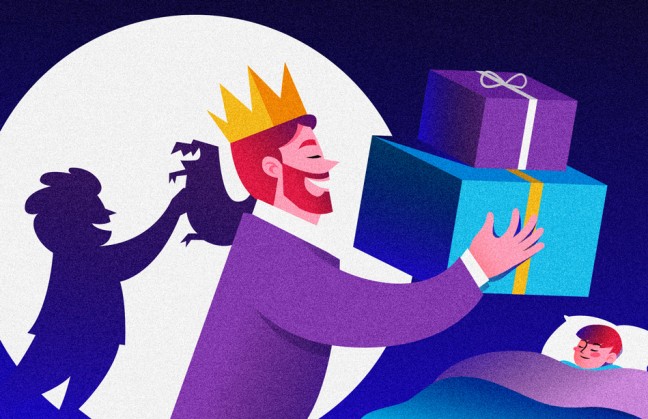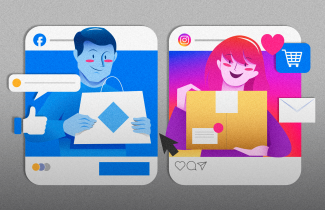Mental Time Travel and Consumption Experiences within Family
How nostalgic memories affect our consumption behavior

Remember (Re-memor ‘mindful’) is, etymologically, “call to the mind again”. Memories undoubtedly connect us with the original emotion, as if we were once more feeling what we remember. Many parents, when they see their children’s excitement about opening presents – for example, on Christmas Day or Epiphany (Three Wise Men Day) – are transported to their own childhood, even experiencing emotions of nostalgia.
Although the word ‘nostalgia’ comes from the Greek meaning “return home + pain” –hence the melancholic patina of this term– it usually appears as a positive evocation of past personal experiences. Nostalgia helps people travel back in time to connect their past selves with their present selves, producing feelings of familiarity. However, the effects of nostalgia can also take place in a consumer context, increasing positive feelings towards certain brands or products.
To find out how nostalgia affects consumption, in 2022, Manuel Sotelo Duarte and Rajagopal, professors at the Business School and EGADE Business School of Tecnológico de Monterrey, respectively, published in the Qualitative Research Journal the paper “Experiencing time elapse phenomenon in nostalgia: effect on consumption behavior in adulthood.” This study shows that, in the context of the parent-child relationship, shared nostalgia is useful for creating new, stronger ties and bonds between parents and children. The nostalgic person goes backwards and forwards in time through memory retrieval, but the quality of this retrieval is related to the social impact during the process of memory creation and retrieval.
Consequently, companies can develop strategies focused on social moments around their brands to increase memory retrieval quality. The hypothesis is that these social moments can trigger nostalgia and detonate consumption behaviors.
Social interaction and the generation of memories
Social learning is the capacity to learn from the people around us through interaction, but also through observation, teaching, and imitation. Social interaction is important for retrieving recollections and creating memories that can benefit the social learning process.
In fact, creating a memory with someone else increases the possibility of retrieving that memory and the quality of the details, since we value our past based on positive events and experiences with other people.
Childhood experiences and memories help us build our personality as individuals, acquiring the skills, knowledge, and attitudes necessary to function in social life and in business environments through socialization with agents such as family or colleagues. In this way, we also learn about consumption through social learning: an example is online shopping, where forums, communities, and reviews have a significant influence on consumer behavior. Moreover, memories can be part of the decision-making process in consumer situations.
The importance of family and friends
This study is based on 30 in-depth interviews with young adults who display nostalgic behavior. Participants in this study found it easy to retrieve their childhood memories; however, a few of the details were elusive in the first retrieval. There were some actions that helped them obtain more details to fully represent the memory: by engaging in a conversation or coming into contact with the places or elements associated with the memories.
In this regard, the study found that social groups can be facilitators of nostalgic behavior, including family and childhood or school friends. These groups reinforce nostalgic behavior by reliving memories through conversation. In childhood memories, the people involved in this remembrance make the event important and enhance the details associated with the memory. Therefore, the memories created with another person are easier to retrieve due to the emotions they contain.
The benefits of nostalgia
Nostalgia is linked to a person's unique memories, and its presence increases memory retrieval and emotional responses. Nostalgic narratives normally cover personally significant childhood memories or pivotal events involving people close to us. Objects connected with pleasant memories and emotions can also be laden with nostalgia.
The main psychological benefits of nostalgia are:
- Increased self-esteem
- Identity continuity
- Social connection
- Optimism
- Escape mechanism for catastrophic situations
- Strategy to face threats and stressful scenarios
The impact of nostalgia is not limited to a particular moment in an individual's life but can be transferred intergenerationally through frequent exposure to other people's nostalgic memories, producing psychological benefits similar to personal nostalgia. In terms of consumption, nostalgia has a positive effect on attitudes towards products or brands, price perception, new-product adoption, and purchase intention.
Mental time travel
This research is based on the theories of nostalgia, memories and social learning, and takes up some of the concepts of the formation of memories and their relationship with decision making. In this sense, Mental time travel (MTT) is the capacity to travel back in time by retrieving memories and using them for future events.
The participants in this research are parents who use MTT to compare their own childhood with their children’s experiences. People undoubtedly trust their autobiographical memories since they are related to personal life experiences, and it is easier for our memory to retrieve the positive ones. Mental Time Travel (MTT) takes us back to multiple past events, a process that can lead to nostalgia, which is a longing for the past. Nostalgia strengthens our self-concept by connecting autobiographical memories with the present self, providing a source of self-continuity that allows individuals to connect their past self with their present self through social connection.
Nostalgic people constantly engage in MTT, using past experiences to cope with future situations. By going back to nostalgic memories, they find experiences with positive brands and associations and try to recreate the experience on their own, or with family or friends. Recreating nostalgic experiences involves social learning that forges new behavior patterns for nostalgic people.
Practical implications for consumption
Brands often emerge in nostalgic memories, helping to develop nostalgic experiences. For example, nostalgic parents translate their nostalgia into buying toys or video games to share with their children. Shared nostalgia between parents and their children develops a new and stronger bond in which parents connect with a younger version of themselves and with their children, through both memories and the product.
This research suggests that MTT and nostalgia are part of consumers’ daily life. Consumers come across a stimulus associated with a childhood memory, creating nostalgia. Then, through MTT, the memories are retrieved and used to predict future scenarios and to act nostalgically about the situation, for example, by making consumption decisions.
This study has practical implications for marketing professionals. Brand communication should highlight social elements to connect with consumers, given the social aspect of nostalgic behavior. In other words, consumers want to share nostalgia. Parents want to replicate their nostalgic experiences with their children through products that have nostalgic meanings. Consequently, brands can use this scenario of sharing parent-child memories in their communication, while attracting new consumers by promoting nostalgic experiences.
The authors are Research Professors at Tec's Undergraduate Business School (Manuel Sotelo) and EGADE Business School (Rajagopal).




